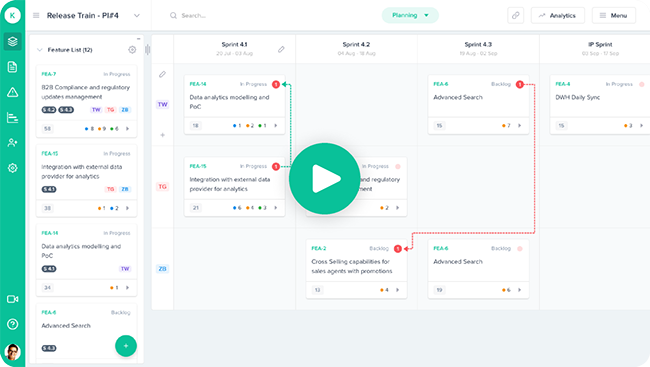The most vital component of achieving anything of value and essentially the backbone of SAFe, is the Program Increment (PI). A Program Increment is timeboxed to 8-12 weeks, where an Agile Release Train, which is constituted of multiple agile teams work towards accomplishing the objectives of the PI. An Agile Release Train may usually consist of 50-125 practitioners. Before any PI, it is customary to have a PI Planning session. It is instrumental in preparing all the activities that will be done during a PI’s course. It is an event in which all of the members of the Agile Release Train and the stakeholders, led by the Release Train Engineer, gather together to work out what needs to be done in the PI.
This is sufficient to entertain all the needs of a single Agile Release Train. But what happens if there are multiple Agile Release Trains working towards creating a single product? What happens when the scope becomes so big and complex and instead of dealing with just a maximum of a hundred individuals, the number of individuals multiplies to hundreds or even a thousand?

The Solution Train
This is when a Solution Train comes into action. It is formed by the combination of multiple Agile Release Trains collated together to work on a large single product. The Solution Train helps in brilliantly aligning and collaborating the huge amount of work and a large number of people involved. Everything operates similar to the activities of a typical Agile Release Train with a few exceptions. Apart from having newer roles added, there are planning activities that supplement the Solution Train. These planning activities are called the Pre and Post PI Planning sessions.Pre and Post PI Planning
The Pre and Post PI Planning sessions are needed for planning a Solution Train because a single PI Planning session does not suffice to cover all the massive aspects of the work that needs to be done. These sessions provide a follow-up and ensure a higher level of consistency, alignment, and accuracy when working. Thus everything of the PI, for the Solution Train, needs to be planned extensively, meticulously and carefully, keeping in mind that everything remains focused on the vision and the goals you want to achieve. The Pre and Post PI Planning sessions, guarantees in building a consolidated plan for the Solution Train to follow. We will now shift our focus on knowing more about the Post PI Planning Session. By the end of every Post PI Planning session, you have finalized PI Objectives that have to be implemented, all the expected dates and milestones for delivering the final increment that are mapped on to a physical or a Digital Solution Board. This board helps in visualizing all the work that is being undertaken by the various Agile Release Trains of the Solution Train.
But how exactly do you reach these conclusions? We shall now discuss what is needed for a Post PI Planning session, who are the participants, how the planning is done and the benefits of this session.
What is needed for a Post PI Planning Session?
- Solution Roadmap – A strategic plan of all the events that will occur in the future of the Program Increment and that need to be delivered by the Solution Train
- Solution Vision – This describes the future of what will be built by the Solution Train keeping in mind the needs of the customers and stakeholders.
- Solution Backlog – A list of all the Features and Capabilities that the Solution Train has to work on.
- Executive Briefing of the Current Business and Solution
- Milestone Definition – They are points or checkmarks on a developmental timeline that are helpful in knowing and monitoring the progress.
Participants
- Release Train Engineers of the participating Agile Release Trains
- Solution Train Engineer – Responsible for coordinating and facilitating Release Train Engineers of multiple Agile Release Trains
- Product Management – Work with the customer and Product Owners to better understand what they really want. Each Agile Release Train has their own Product Management
- Solution Architect – Describes the technical architectural vision of the entire solution
- Stakeholders
The session starts when the Product Management of each ART presents and discusses their PI Plans with all the other participating Agile Release Trains. RTEs explain and discuss the objectives, dependencies, impediments and the risks of the PI. Risks are identified and mitigated, using the ROAM technique. If there are any aspects of the planning session that are left or not clearly understood, then a Rework Session is held to review the plan with the Agile Release Trains involved. Lastly, a short retrospective is kept just to ensure that everything is aligned and on track with being executed in the PI.
This concludes the Post PI Planning session. By the end of this session, you would have a set of objectives for your PI which have been finalized after very extensive planning and analysis.
Benefits of the Post PI Planning Session
- Aligning, supporting and coordinating multiple Agile Release Trains involved.
- Helps to build a plan for the next PI.
- Gaining useful insights into the Solution Demo events.
- Allows to build a plan for large value streams.
- Retrospective lets the team learn and relentlessly improve.
- Gives an opportunity to do Rework for anything that may have been missed.
Unleash Your Organization’s True Potential to Scale Agile with Kendis
Kendis offers an all-inclusive solution to planning, tracking and managing your Program Increment and dependencies between distributed teams. It works on top of JIRA and other agile tools, your teams can keep on working with their existing JIRA boards and program level and above is planned and managed at Kendis.
Try out 10 days free trial or book a demo with our product expert.
Kendis is a digital solution for PI, Tribe and Big room Planning that works on top of Jira and Azure Boards.










